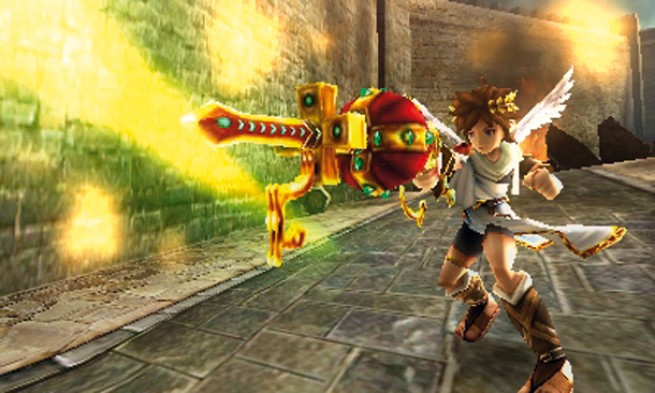26 years have passed since Kid Icarus was released for the Nintendo Entertainment System. Aside from a forgotten handheld sequel for the Game Boy in 1991, the series has remained dormant for several generations. Resurrecting an ancient game franchise is no small task, especially when the developer has over two decades of rose-tinted memories to take into account.
I would have happily accepted an HD remake of the original, but Nintendo and Project Sora have opted to provide something far more ambitious. That ambition succeeds as often as it fails, making for a bittersweet comeback for this beloved 8-bit title.
WHAT YOU’LL LIKE
Personality
It’s always a gamble when a company tries to infuse copious amounts of humor and voice-acting into a game that never had it before. Sure, the original Kid Icarus had a certain charm to it, but the limitations of the hardware left a lot up to the imagination. Pit, the series protagonist, was little more than a bundle of pixels that moved across the screen collecting hearts, avoiding being turned into an eggplant, and relaxing at the occasional hot springs.
 Kid Icarus: Uprising not only gives Pit a voice (and one he uses often), but also every other character: Medusa, Palutena (the Goddess of Light), and even boss monsters. The banter in this game walks a thin line between stupid and witty, but for the most part I felt it landed on the right side of the fence. There’s more than a few self-aware references, talking about what things were like “in the 80’s,” remembering how a certain item looked a lot more pixelated the last time it was seen–basically, the fourth wall does not exist here. Imagine if Deadpool were a writer for Nintendo, instead of a psychopathic murderous assassin.
Kid Icarus: Uprising not only gives Pit a voice (and one he uses often), but also every other character: Medusa, Palutena (the Goddess of Light), and even boss monsters. The banter in this game walks a thin line between stupid and witty, but for the most part I felt it landed on the right side of the fence. There’s more than a few self-aware references, talking about what things were like “in the 80’s,” remembering how a certain item looked a lot more pixelated the last time it was seen–basically, the fourth wall does not exist here. Imagine if Deadpool were a writer for Nintendo, instead of a psychopathic murderous assassin.
Where the dialogue in some games is either too little or so poor that it negatively impacts the entire experience, the characters and humor in Uprising kept propelling me along each level without ever losing interest. Unfortunately, Nintendo couldn’t maintain that high level of quality for the entire game, but we’ll get to that on the next page.
Aerial sequences
As a devout fan of Panzer Dragoon and StarFox, as well as plenty of maniacal bullet-hell shooters like Ikaruga and Espgaluda II, I’ve never had anything against the on-rails shooter genre. To my delight, every level in Uprising starts with an aerial sequence with Palutena guiding Pit along a set flight path while he dodges and shoots down enemies. I was especially impressed by how varied and unique each environment was. Whether it was battling space pirates, entering the pathway between parted seas, or Pandora’s abstract Labyrinth of Deceit, the game always managed to keep things fresh and visually compelling.
The second–and usually much longer–half of each level is an on-foot excursion that plays entirely differently from the aerial portion. While these are not necessarily bad (and make for a solid throwback to the more traditional Kid Icarus gameplay), they aren’t quite as thrilling. I’m not saying they shouldn’t have been included, but I also wouldn’t have complained if Pit stuck to the skies.
Weapon variety
At the heart of Uprising is an incredibly deep weapon and power system. There are nine different types of weapons, from staffs and bows to cannons, claws, and clubs. Each weapon type has its own attack pattern and strengths/weaknesses, but there are also dozens of unique weapons that fall within the different types. Without a doubt these are some of the game’s most imaginative assets, which is actually saying a lot given the high quality of the overall audio/visual offerings.
You can also find, buy, or create higher quality versions of identical weapons, so that you may have a really weak Doom Cannon, and then a really powerful one with lots of bonus attributes and attack power. The possibilities aren’t quite endless, but the weapon system is definitely the backbone of Uprising’s replayability.
There is a highly useful training area where you can try weapons on and compare damage output, but it would have been nice if you could also do this with weapons you haven’t bought or created yet.
Multiplayer
Multiplayer in Uprising plays out like a combination of Super Smash Bros. and Sega’s Virtual On. Up to six players battle it out in team versus or free-for-all mode, strafing and shooting and collecting power-ups and exploding in a pillar of light whenever defeated.

I learned pretty quickly to bring my A-game into multiplayer battles, as I was playing mostly at 2 or 3 in the morning against Japanese players, all of whom had top tier weaponry and powers that I hadn’t even heard of yet. Luckily, even if you underperform, you can still earn hearts or gain random weapons, so your time spent in Together mode doesn’t feel wasted.
Despite usually battling five players on the other side of the world, lag seemed minimal, though I did have a few matches where lag rendered the game entirely unplayable. The action doesn’t slow down at all, but you won’t be able to hit anything even when it’s right in front of you, and instead you’ll find yourself being hit by invisible attacks or enemies. Matches against Western players were notably better on average.


